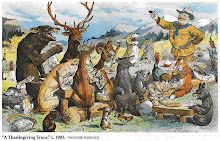Bear DNA collection tallies 100 grizzlies
producer.com
Ranchers in southwestern Alberta frequently see grizzly bears on their land. Sometimes they see them from a distance and sometimes from uncomfortably close up.Just how many grizzlies are in the region?
Andrea Morehouse, co-ordinator of the grizzly bear monitoring project, has an answer devised from two years of hair sample collection."What we can say right now is that we identified over 100 individual grizzly bears last year through our sampling," she said June 19 during a tour of grizzly bear-related sites near Waterton National Park.
The joint project of Alberta Environment, Alberta Parks, Parks Canada and the University of Alberta aims to monitor grizzly bear population, density and distribution in an area south of Highway 3, west to British Columbia, south to Montana and east to the edge of grizzly bear range.
There are now two years of data, and Morehouse's team is entering the third season of collecting bear hair from 831 rub objects, most of them trees to which they have affixed barbed wire to facilitate hair collection.
Grizzly bears' habit of rubbing is thought to be a form of communication, said Morehouse. But they might also simply be itchy.She hopes to eventually have an accurate population estimate for this area, where conflicts between bears and people seem to be on the rise.
Sites are located on public lands, in parks and on private and leased land. More than 60 landowners and grazing co-ops are involved in the study area.
Hair collection for 2013 has just begun. Morehouse and her team will visit each of the 831 sites eight times between now and November.Data from 2011 and 2012 must still be verified and examined. Morehouse knows some of the bears identified in 2012 will be the same ones sampled in 2011. As well, more rub sites were added in 2012, so the number does not necessarily represent an increase. However, other data suggests the grizzly population in the region is growing by three to six percent annually.
Individual identification doesn't necessarily mean the grizzlies are still in the region because they range into British Columbia and Montana. Early data shows 60 percent of the samples come from males, even though ranchers more frequently see sows and cubs.
"We know that the males rub more than females so we know that our sampling tends to bias more toward the males," Morehouse said.
More females were sampled in 2012 than 2011, she added.
A scientifically reliable estimate of the grizzly bear population will give direction on the status of grizzlies, which are now designated as threatened under the provincial wildlife act. It could also indicate whether control of their numbers is needed or wanted.
"One of the things that we're really interested in is, are the bears that are involved in these conflicts, is it the same bear over and over again, or is it multiple different bears? And ultimately what is the relatedness between those bears," said Morehouse.
Hair samples are also accepted from ranchers and landowners who find them on fences, sheds, granaries or trees. A GPS location is ideal, but failing that, a land description will do.











No comments:
Post a Comment